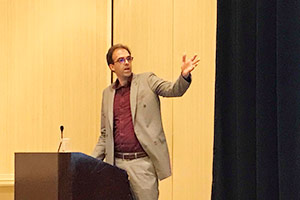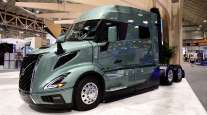Autonomous Advancements Present Opportunities for Drivers, Experts Say

SAN DIEGO — Autonomous mobility experts said that the technology can open up new opportunities for drivers, noting that as progress on greater levels of automation expands over time, drivers will have chances to capitalize on that change.
“There are going to be a lot of situations where we can enhance the capabilities of the driver by providing the information technology,” Jenny Elfsberg, Volvo’s director of the innovation lab for connected vehicles, said during a Feb. 25 panel on autonomous technology here at the Lytx User Group Conference. “I think we should do our best in this industry to make the truck drivers, or the excavator operators, or the bus drivers, become the heroes of the transport society. They can actually move up a little bit.”
More From the Conference
“Our view is the driver of the future looks like the driver of today — they’re doing a lot of the same things but in different domains,” added Alden Woodrow, co-founder and CEO of autonomous truck technology developer Ike, which is focused on creating fully autonomous trucks that can operate safely on interstate highways and bring value to fleets. “We are really focused on making the trucking industry better.”
Woodrow outlined a model in which drivers would take loads to drop-off points near interstates, where autonomous trucks would then take over for long stretches of highway. “The approach we want to take is to bring new technology to the industry in a complementary way,” he said. “The highway is very structured. You have access control, there are no stop signs and stoplights, and most of the things are driving in a straight line in the same direction most of the time.”
While Woodrow sees these as factors that could make the case for unmanned trucks on the highway, he sees getting the cargo to those drop points as a long-term role for drivers. “The driving jobs on either end become more like local or regional haul,” he said. “We also want to be complementary for drivers, and quite good for drivers. We want to make the industry more productive.”
“For on-highway, there is a huge benefit” to automation, Elfsberg added. “We all know how boring it is. Driving long distances, it would be really great to just let the machine take over.”
In other applications, such as construction, she noted that automation could bring change to the equipment that companies use.
“For many, many years, dump trucks and haulers have increased in size, because that is the only way to drive efficiently when you have a driver in the cab,” she said. “With automation, we can consider making smaller machines. One huge hauler can be replaced by a bunch of smaller transport solutions. When they get smaller, they can actually be battery-electric.” Elfsberg noted, however, that with all of these advancements must also come an accompanying evolution in connected technology.

Ognen Stojanovski, co-founder and CEO of autonomous technology developer Pronto. (Joe Howard/Transport Topics)
A more integrated approach to automated technology is one supported by Ognen Stojanovski, co-founder and CEO of autonomous technology developer Pronto and, along with Woodrow, a veteran of the former autonomous truck developer Otto, which later was acquired by Uber.
While Woodrow and Stojanovski were once colleagues, Stojanovski has a different view of how automated technology will roll out over time. At Pronto, Stojanovski is working toward a more gradual approach, believing that the goal of full automation may be too idealistic.
“The big idea is that it’s not going to be a bunch of unmanned, driverless vehicles on the road criss-crossing long stretches of roads,” he said. “We think there will be some unmanned vehicles, at least initially. They’re going to be sprinkled into a vast ecosystem where it is primarily traditionally driven trucks, or trucks with really advanced driver-assistance technologies. The way we think to actually get there is this mixed model.”
Stojanovski cited steering automation as an example of a technology that could be integrated quickly, and begin paying dividends by helping drivers keep trucks centered in the lane, and even intervene in instances such as medical emergencies.
“Drivers are more inclined to embrace technology if they think they are getting something out of it,” he said.





